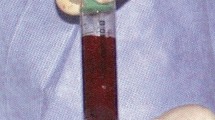Abstract
Femoral head bone allografts have traditionally been used to provide mechanical stability to areas of bony deficiency, or for its osteoinductive and osteoconductive properties. Concerns have been raised over increased infection rates following the use of fresh-frozen graft tissue. This retrospective study aims to investigate the outcomes of fresh frozen femoral heads kept in a regulated, non-commercial bone bank at a university teaching hospital.The local bone bank database was used to identify released femoral heads during a 14 year study period (September 1999–December 2013) whereby a retrospective review of patient records was undertaken to determine clinical outcome. During the observed study period, 427 femoral heads were released from cold storage. Of these, 270 femoral heads had a mean follow-up of 347 days. 157 femoral heads were excluded due to insufficient follow-up data (n = 132) or discarded due to breaks in the cold chain prior to use (n = 25). Of the 270 included femoral heads, 231 (85.6 %) had no reported complications with good graft incorporation. In the remaining 39 with reported complications, only 5 (2.6 %) developed a postoperative infection. Our findings suggest that the use of fresh frozen allograft does not materially increase the risk of post-operative bacterial infection. Our reported post-operative infection rates are comparable with infection rates of other similar studies on fresh frozen allograft use.

Similar content being viewed by others
References
Abbey DM, Turner DM, Warson JS, Wirt TC, Scalley RD (1995) Treatment of postoperative wound infections following spinal fusion with instrumentation. J Spinal Disord Tech 8:278–283
Boyce T, Edwards J, Scarborough N (1999) Allograft bone: the influence of processing on safety and performance. Orthop Clin N Am 30:571–581
Buckley S, Stockley I, Hamer A, Kerry R (2005) Irradiated allograft bone for acetabular revision surgery results at a mean of five years. J Bone Joint Surg Br 87:310–313
Comba F, Buttaro M, Pusso R, Piccaluga F (2009) Acetabular revision surgery with impacted bone allografts and cemented cups in patients younger than 55 years. Int Orthop 33:611–616
Costain DJ, Crawford RW (2009) Fresh-frozen vs. irradiated allograft bone in orthopaedic reconstructive surgery. Injury 40:1260–1264
Giannoudis PV, Dinopoulos H, Tsiridis E (2005) Bone substitutes: an update. Injury 36:S20–S27
Haddad F, Muirhead-Allwood S, Manktelow A, Bacarese-Hamilton I (2000) Two-stage uncemented revision hip arthroplasty for infection. J Bone Joint Surg Br 82:689–694
Hou C-H, Yang R-S, Hou S-M (2005) Hospital-based allogenic bone bank—10-year experience. J Hosp Infect 59:41–45
Kappe T, Cakir B, Mattes T, Reichel H, Flören M (2010) Infections after bone allograft surgery: a prospective study by a hospital bone bank using frozen femoral heads from living donors. Cell Tissue Bank 11:253–259
Kostuik J, Israel J, Hall JE (1973) Scoliosis surgery in adults. Clin Orthop Relat Res 93:225–234
Kwong F, Ibrahim T, Power R (2005) Incidence of infection with the use of non-irradiated morcellised allograft bone washed at the time of revision arthroplasty of the hip. J Bone Joint Surg Br 87:1524–1526
Lonstein J, Winter R, Moe J, Gaines D (1973) Wound infection with Harrington instrumentation and spine fusion for scoliosis. Clin Orthop Relat Res 96:222–233
Mitchell EJ, Stawarz AM, Kayacan R, Rimnac CM (2004) The effect of gamma radiation sterilization on the fatigue crack propagation resistance of human cortical bone. J Bone Joint Surg Br 86:2648–2657
Morscher E, Babst R, Jenny H (1990) Treatment of infected joint arthroplasty. Int Orthop 14:161–165
Olsen MA, Mayfield J, Lauryssen C, Polish LB, Jones M, Vest J, Fraser VJ (2003) Risk factors for surgical site infection in spinal surgery. J Neurosurg Spine 98:149–155
Palmer S, Gibbons C, Athanasou N (1999) The pathology of bone allograft. J Bone Joint Surg Br 81:333–335
Ridgeway S, Wilson J, Charlet A, Kafatos G, Pearson A, Coello R (2005) Infection of the surgical site after arthroplasty of the hip. J Bone Joint Surg Br 87:844–850
Roberts FJ, Walsh A, Wing P, Dvorak M, Schweigel J (1998) The influence of surveillance methods on surgical wound infection rates in a tertiary care spinal surgery service. Spine 23:366–370
Schreurs BW, Bolder SBT, Gardeniers JWM, Verdonschot N, Slooff TJJH, Veth RPH (2004) Acetabular revision with impacted morsellised cancellous bone grafting and a cemented cup: a 15- to 20-year follow-up. J Bone Joint Surg Br 86:492–497. doi:10.1302/0301-620x.86b4.14769
Sutherland A, Raafat A, Yates P, Hutchison J (1997) Infection associated with the use of allograft bone from the north east Scotland Bone Bank. J Hosp Infect 35:215–222
Wu C, Hsieh P, Jiang JF, Shih H, Chen C, Hu C (2015) A positive bacterial culture from allograft bone at implantation does not correlate with subsequent surgical site infection. Bone Joint J 97:427–431
Yano K, Minoda Y, Sakawa A, Kuwano Y, Kondo K, Fukushima W, Tada K (2009) Positive nasal culture of methicillin-resistant Staphylococcus aureus (MRSA) is a risk factor for surgical site infection in orthopedics. Acta Orthop 80:486–490
Acknowledgments
The authors declare that they have no conflicts of interest in the authorship or publication of this article.
Author information
Authors and Affiliations
Corresponding author
Rights and permissions
About this article
Cite this article
Man, W.Y., Monni, T., Jenkins, R. et al. Post-operative infection with fresh frozen allograft: reported outcomes of a hospital-based bone bank over 14 years. Cell Tissue Bank 17, 269–275 (2016). https://doi.org/10.1007/s10561-016-9547-8
Received:
Accepted:
Published:
Issue Date:
DOI: https://doi.org/10.1007/s10561-016-9547-8




